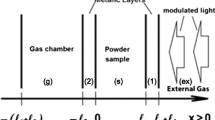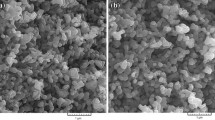Abstract
Poly(l-lactic acid)/hydroxyapatite (PLLA/HA) nanocomposite, which combines the properties of PLLA and HA, is suitable to construct scaffold for bone tissue engineering. Its mineralization behavior plays a key role in composite’s property. In this present work, two PLLA/HA composites with porous and compact architecture were fabricated and soaked into simulated body fluid (SBF) at 37 °C for in vitro mineralization, respectively. An attenuated total reflection Fourier transform infrared (ATR FTIR) mapping coupled with principal component analysis was developed to investigate the mineralization kinetics. The FTIR images with an area of 300 × 300 μm2 were collected every 7 days. The results suggest that the mineralization of PLLA/HA composites in SBF follows a zero-order kinetic model, no matter what the architecture is. However, it follows a second-order model when the composite is degraded in phosphate-buffered saline solution based on our previous work. The mechanisms of the in vitro mineralization kinetics in different submersion solutions are discussed. Our results alert researchers that they should choose the mineralization medium cautiously.








Similar content being viewed by others
References
Stock UA, Vacanti JP (2001) Tissue engineering: current state and prospects. Annu Rev Med 52:443–451
Liu XH, Holzwarth JM, Ma PX (2012) Functionalized synthetic biodegradable polymer scaffolds for tissue engineering. Macromol Biosci 12:911–919
Stevens MM, George JH (2005) Exploring and engineering the cell surface interface. Science 310:1135–1138
Wei GB, Ma PX (2009) Partially nanofibrous architecture of 3D tissue engineering scaffolds. Biomaterials 30:6426–6434
Karageorgiou V, Kaplan D (2005) Porosity of 3D biomaterial scaffolds and osteogenesis. Biomaterials 26:5474–5491
Hutmacher DW (2000) Scaffolds in tissue engineering bone and cartilage. Biomaterials 21:2529–2543
Bose S, Roy M, Bandyopadhyay A (2012) Recent advances in bone tissue engineering scaffolds. Trends Biotechnol 30:546–554
Khakestani M, Jafari SH, Zahedi P, Bagheri R, Hajiaghaee R (2017) Physical, morphological, and biological studies on PLA/nHA composite nanofibrous webs containing Equisetum arvense herbal extract for bone tissue engineering. J Appl Polym Sci 134:45343
Armentano I, Dottori M, Fortunati E, Mattioli S, Kenny JM (2010) Biodegradable polymer matrix nanocomposites for tissue engineering: a review. Polym Degrad Stab 95:2126–2146
Thein-Han WW, Misra RDK (2009) Biomimetic chitosan–nanohydroxyapatite composite scaffolds for bone tissue engineering. Acta Biomater 5:1182–1197
Swetha M, Sahithi K, Moorthi A, Srinivasan N, Ramasamy K, Selvamurugan N (2010) Biocomposites containing natural polymers and hydroxyapatite for bone tissue engineering. Int J Biol Macromol 47:1–4
Marelli B, Ghezzi CE, Barralet JE, Boccaccini AR, Nazhat SN (2010) Three-dimensional mineralization of dense nanofibrillar collagen–bioglass hybrid scaffolds. Biomacromolecules 11:1470–1479
Choi S-W, Zhang Y, Thomopoulos S, Xia Y (2010) In vitro mineralization by preosteoblasts in poly(dl-lactide-co-glycolide) inverse opal scaffolds reinforced with hydroxyapatite nanoparticles. Langmuir 26:12126–12131
Haimi S, Suuriniemi N, Haaparanta A-M et al (2009) Growth and osteogenic differentiation of adipose stem cells on PLA/bioactive glass and PLA/β-TCP scaffolds. Tissue Eng A 15:1473–1480
Conoscenti G, Pavia FC, Ciraldo FE, Liverani L, Brucato V, La Carrubba V, Boccaccini AR (2018) In vitro degradation and bioactivity of composite poly-l-lactic (PLLA)/bioactive glass (BG) scaffolds: comparison of 45S5 and 1393BG compositions. J Mater Sci 53:2362–2374. https://doi.org/10.1007/s10853-017-1743-9
Riteau N, Sher A (2016) Chitosan: an adjuvant with an unanticipated STING. Immunity 44:522–524
Park S-B, Lih E, Park K-S, Joung YK, Han DK (2017) Biopolymer-based functional composites for medical applications. Prog Polym Sci 68:77–105
Bhattacharjee P, Kundu B, Naskar D, Kim H-W, Maiti TK, Bhattacharya D, Kundu SC (2017) Silk scaffolds in bone tissue engineering: an overview. Acta Biomater 63:1–17
Zhong QW, Li WH, Sua XP, Li G, Zhou Y, Kundub SC, Yao J, Cai Y (2016) Degradation pattern of porous CaCO3 and hydroxyapatite microspheres in vitro and in vivo for potential application in bone tissue engineering. Colloids Surf B 143:56–63
Webster TJ, Ergun C, Doremus RH, Siegel RW, Bizios R (1999) Specific proteins mediate enhanced osteoblast adhesion on nanophase ceramics. J Biomed Mater Res 20:1221–1227
Naderi H, Matin MM, Bahrami AR (2011) Review paper: critical issue in tissue engineering: biomaterials, cell sources, angiogenesis, and drug delivery system. J Biomater Appl 26:383–417
Díaz E, Sandonis I, Puerto I, Ibáñez I (2014) In vitro degradation of PLLA/nHA composite scaffolds. Polym Eng Sci 54:2571–2578
Gentile P, Chiono V, Carmagnola I, Hatton PV (2014) An overview of poly(lactic-co-glycolic) acid (PLGA)-based biomaterials for bone tissue engineering. Int J Mol Sci 15:3640–3659
Place ES, George JH, Williamsc CK, Stevens MM (2009) Synthetic polymer scaffolds for tissue engineering. Chem Soc Rev 38:1139–1151
Jiang LY, Xiong CD, Jiang LX, Xu LJ (2014) Effect of hydroxyapatite with different morphology on the crystallization behavior, mechanical property and in vitro degradation of hydroxyapatite/poly(lactic-co-glycolic) composite. Compos Sci Technol 93:61–67
Larránaga A, Aldazabal P, Martin FJ, Sarasua JR (2014) Hydrolytic degradation and bioactivity of lactide and caprolactone based sponge-like scaffolds loaded with bioactive glass particles. Polym Degrad Stab 110:121–128
Zhou ZH, Yi QF, Liu LH, Liu XP, Liu QQ (2009) Influence of degradation of poly-l-lactide on mass loss, mechanical properties, and crystallinity in phosphate-buffered solution. J Macromol Sci B 48:309–317
Zhang J, Yang SG, Ding JX, Li ZM (2016) Tailor-made poly(l-lactide)/poly(lactide-coglycolide)/hydroxyapatite composite scaffolds prepared via high-pressure compression molding/salt leaching. RSC Adv 6:47418–47426
Rodenas-Rochina J, Vidaurre A, Cortázar IC, Lebourg M (2015) Effects of hydroxyapatite filler on long-term hydrolytic degradation of PLLA/PCL porous scaffolds. Polym Degrad Stab 119:121–131
Davachi SM, Kaffashi B, Torabinejad B, Zamanian A, Seyfi J, Hejazi I (2016) Investigating thermal, mechanical and rheological properties of novel antibacterial hybrid nanocomposites based on PLLA/triclosan/nanohydroxyapatite. Polymer 90:232–241
Ignjatović N, Savić V, Najman S, Plavšić M, Uskoković D (2001) A study of HAp/PLLA composite as a substitute for bone powder, using FT-IR spectroscopy. Biomaterials 22:571–575
Baker MJ, Trevisan J, Bassan P et al (2014) Using Fourier transform IR spectroscopy to analyze biological materials. Nat Protoc 9:1771–1791
Bartnicka AS, Kimber JA, Borkowski L et al (2015) The biocompatibility of carbon hydroxyapatite/β-glucan composite for bone tissue engineering studied with Raman and FTIR spectroscopic imaging. Anal Bioanal Chem 407:7775–7785
Kazarian SG, Chan KLA, Maquet V, Boccaccini AR (2004) Characterisation of bioactive and resorbable polylactide/bioglass composites by FTIR spectroscopic imaging. Biomaterials 25:3931–3938
Wang Q, Jiang XT, Xin YZ, Cui JX, Zhang PD (2014) Characterization of in vitro mineralization of porous poly(l-lactic acid)/bioactive glass composites by attenuated total reflectance-Fourier transform infrared mapping. Chin J Anal Chem 42:221–226
Bartnicka AS, Borkowski L, Ginalska G, Ślósarczyk A, Kazarian SG (2017) Structural transformation of synthetic hydroxyapatite under simulated in vivo conditions studied with ATR-FTIR spectroscopic imaging. Spectrochim Acta A 171:155–161
Wu L, Lv LL, Jing N, Zhang YY, Zhang PD (2013) Hydrothermal synthesis of size-controlled rod-like hydroxyapatite by orthogonal design. Bull Chin Ceram Soc 32:2622–2626
Taherkhani S, Moztarzadeh F (2016) Fabrication of a poly(ε-caprolactone)/starch nanocomposite scaffold with a solvent-casting/salt-leaching technique for bone tissue. J Appl Polym Sci 133:43523
Jiang XT, Wang Q, Zhang PD (2011) Preparation of porous polylactide/hydroxyapatite composites and their in vitro degradation. Chem Res Appl 23:755–760
Kokubo T, Takadama H (2006) How useful is SBF in predicting in vivo bone bioactivity. Biomaterials 27:2907–2915
Zhou SB, Zheng XT, Yu XJ, Wang JX, Weng J, Li XH, Feng B, Yin M (2007) Hydrogen bonding interaction of poly(d,l-lactide)/hydroxyapatite nanocomposites. Chem Mater 19:246–253
Krikorian V, Pochan DJ (2005) Crystallization behavior of poly(l-lactic acid) nanocomposites: nucleation and growth probed by infrared spectroscopy. Macromolecules 38:6520–6527
Jing N, Jiang XT, Wang Q, Tang YJ, Zhang PD (2014) Attenuated total reflectance/Fourier transform Infrared (ATR/FTIR) mapping coupled with principal component analysis for the study of in vitro degradation of porous polylactide/hydroxyapatite composite material. Anal Methods 6:5590–5595
Perssona M, Lorite GS, Kokkonen HE, Cho S-W, Lehenkari PP, Skrifvars M, Tuukkanen J (2014) Effect of bioactive extruded PLA/HA composite films on focal adhesion formation of preosteoblastic cells. Colloids Surf B 121:409–416
Author information
Authors and Affiliations
Corresponding author
Ethics declarations
Conflict of interest
The authors declare that there is no conflict of interest.
Rights and permissions
About this article
Cite this article
Dou, T., Jing, N., Zhou, B. et al. In vitro mineralization kinetics of poly(l-lactic acid)/hydroxyapatite nanocomposite material by attenuated total reflection Fourier transform infrared mapping coupled with principal component analysis. J Mater Sci 53, 8009–8019 (2018). https://doi.org/10.1007/s10853-018-2169-8
Received:
Accepted:
Published:
Issue Date:
DOI: https://doi.org/10.1007/s10853-018-2169-8




